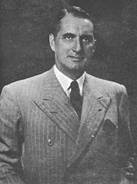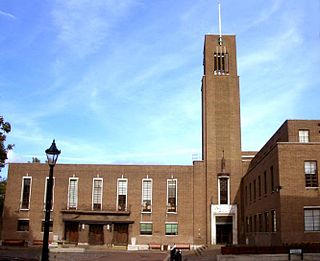
Centenary Square is a public square on the north side of Broad Street in Birmingham, England, named in 1989 to commemorate the centenary of Birmingham achieving city status. The area was an industrial area of small workshops and canal wharves before it was purchased by the council in the 1920s for the creation of a grand civic centre scheme to include museums, council offices, cathedral and opera house. The scheme was abandoned after the arrival of World War II with only the Hall of Memory and half of the planned Baskerville House complete. After the war the scheme was revived in a simpler form however the council never managed to implement the design.
The year 1931 in architecture involved some significant events.

Arnold is a market town in the Borough of Gedling in the county of Nottinghamshire in the East Midlands of England. It is situated to the north-east of Nottingham's city boundary. Arnold has the largest town centre in the Borough of Gedling and the most important town centre in the northeastern part of the conurbation of Greater Nottingham. Gedling Borough Council is headquartered in Arnold. Since 1968 Arnold has had a market, and the town used to have numerous factories associated with the hosiery industry. Nottinghamshire Police have been headquartered in Arnold since 1979. At the time of the 2011 United Kingdom census, Arnold had a population of 37,768.

Although Birmingham in England has existed as a settlement for over a thousand years, today's city is overwhelmingly a product of the 18th, 19th, and 20th centuries, with little surviving from its early history. As it has expanded, it has acquired a variety of architectural styles. Buildings of most modern architectural styles in the United Kingdom are located in Birmingham. In recent years, Birmingham was one of the first cities to exhibit the blobitecture style with the construction of the Selfridges store at the Bullring Shopping Centre.

Harold William "Harry" Weedon was an English architect. Although he designed a large number of buildings during a long career, he is best known for his role overseeing the Art Deco designs of the Odeon Cinemas for Oscar Deutsch in the 1930s. Influenced by the work of Erich Mendelsohn and Hans Poelzig – the Odeons "taught Britain to love modern architecture" and form "a body of work which, with London Underground stations, denotes the Thirties like nothing else".

Robert Atkinson was an English architect primarily working in the Art Deco style.

Nottingham Council House is the city hall of Nottingham, England. The 200 feet (61 m) high dome that rises above the city is the centrepiece of the skyline and presides over the Old Market Square which is also referred to as the "City Centre". It is a Grade II* listed building.

Baskerville House, previously called the Civic Centre, is a former civic building in Centenary Square, Birmingham, England. After serving as offices for the Birmingham City Council, it was extended with additional floors in 2007.

The Twentieth Century Society, founded in 1979 as The Thirties Society, is a British charity that campaigns for the preservation of architectural heritage from 1914 onwards. It is formally recognised as one of the National Amenity Societies, and as such is a statutory consultee on alterations to listed buildings within its period of interest.

Daybrook is a suburb of Arnold, Nottinghamshire. The area is located just outside the city of Nottingham but inside the conurbation of Greater Nottingham. It lies next to the areas of Arnold town centre, Sherwood, Woodthorpe, Redhill and Bestwood.

Stephen Rowland Pierce F.R.I.B.A, F.S.A. (1896–1966) was an architect and town planning consultant. In partnership with Charles Holloway James he designed several large British public buildings, including Norwich City Hall.

The Odeon at Kingstanding, Birmingham, was a 1930s cinema in the Odeon chain. Though closed as a cinema in 1962, the building survives as a bingo hall, and is Grade II listed.

Reginald Harold UrenFRIBA was a New Zealand-born architect who worked in the United Kingdom for most of his career.

The former headquarters of the Birmingham Municipal Bank is a Grade II listed building by Thomas Cecil Howitt opposite what is now Centenary Square at 301 Broad Street, Birmingham, England.

Samuel Dutton Walker F.S.A. was an architect based in Nottingham.

Albert Nelson Bromley was an English architect based in Nottingham.

Charles Leighfield Jonah Doman FRBS was a sculptor from Nottingham.

Storyhouse is a large, mixed-use cultural building in Chester, England, which opened in May 2017. The complex includes a theatre, cinema, restaurant and the city library. It is housed in the remodelled 1936 Odeon Cinema, a grade-II-listed building, together with a newly built extension to hold the theatre auditorium.

Staythorpe is a hamlet and civil parish in the Newark and Sherwood district of Nottinghamshire, England. During the 2021 census, the population was recorded as 93 residents.

The Odeon Cinema is a cinema in Harrogate, in North Yorkshire, England. Built in 1936, it is notable for its Art Deco style. It is a Grade II listed building.




























